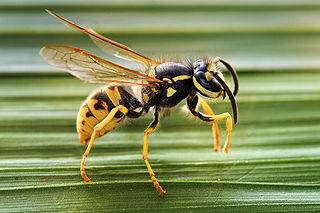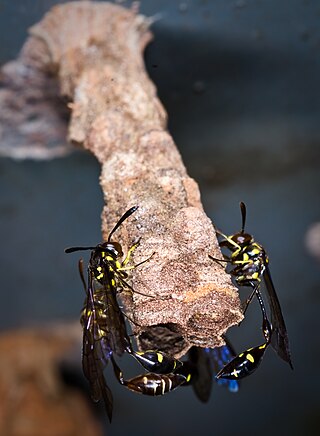
The Vespidae are a large, diverse, cosmopolitan family of wasps, including nearly all the known eusocial wasps and many solitary wasps. Each social wasp colony includes a queen and a number of female workers with varying degrees of sterility relative to the queen. In temperate social species, colonies usually last only one year, dying at the onset of winter. New queens and males (drones) are produced towards the end of the summer, and after mating, the queens hibernate over winter in cracks or other sheltered locations. The nests of most species are constructed out of mud, but polistines and vespines use plant fibers, chewed to form a sort of paper. Many species are pollen vectors contributing to the pollination of several plants, being potential or even effective pollinators, while others are notable predators of pest insect species, and a few species are invasive pests.

Vespula is a small genus of social wasps, widely distributed in the Northern Hemisphere. Along with members of their sister genus Dolichovespula, they are collectively known by the common name yellowjackets in North America. Vespula species have a shorter oculomalar space and a more pronounced tendency to nest underground than Dolichovespula.

Paper wasps are a type of vespid wasps. The term is typically used to refer to members of the vespid subfamily Polistinae, though it often colloquially includes members of the subfamilies Vespinae and Stenogastrinae, which also make nests out of paper.

Polistes is a cosmopolitan genus of paper wasps and the only genus in the tribe Polistini. Vernacular names for the genus include umbrella wasps, coined by Walter Ebeling in 1975 to distinguish it from other types of paper wasp, in reference to the form of their nests, and umbrella paper wasps. Polistes is the single largest genus within the family Vespidae, with over 200 recognized species. Their innate preferences for nest-building sites leads them to commonly build nests on human habitation, where they can be very unwelcome; although generally not aggressive, they can be provoked into defending their nests. All species are predatory, and they may consume large numbers of caterpillars, in which respect they are generally considered beneficial.

Dolichovespula is a small genus of social wasps distributed widely throughout the Northern Hemisphere. The yellow and black members of the genus are known by the common name yellowjackets in North America, such as Dolichovespula norwegica, along with members of their sister genus Vespula. In a study on the nesting biology of Dolichovespula, a colony of D. maculata with 771 workers was reported as having the largest recorded population count.

Provespa is a small genus of Vespidae, made up of nocturnal wasps from Southeast Asia, sometimes referred to as "night wasps" or "night hornets", though they are not true hornets. They are the only nocturnal members of the subfamily Vespinae, and also the only vespines where new colonies are formed by swarming. They tend to build their nests from fibrous plant material, making them a uniform greyish brown colour which is often difficult to locate.

The Stenogastrinae are a subfamily of social wasps included in the family Vespidae. They are sometimes called hover wasps owing to the particular hovering flight of some species. Their morphology and biology present interesting peculiarities.

Alastor is a Palearctic, Indomalayan and Afrotropical genus of potter wasps, primarily found in tropical Africa. It is divided into the 4 subgenera Alastor, Alastorellus, Megalastor and Parastalor.

Synagris is an Afrotropical genus of large potter wasps. Several Synagris wasps are strongly sexually dimorphic and males bear notable morphological secondary sexual traits including metasomal lamellar or angular protruding structures and hornlike or tusklike mandibular and/or clypeal projections.

Ropalidia is a large genus of eusocial paper wasps (Polistinae) in the tribe Ropalidiini distributed throughout the Afrotropical, Indomalayan and Australasian biogeographical regions. The genus Ropalidia is unusual because it contains both independent and swarm-founding species. Ropalidia romandi is one of the swarm founding species, meaning that new nests are founded by a large group of workers with a smaller number of inseminated females, while Ropalidia revolutionalis is independent-founding, meaning that each nest is founded by a single foundress.
Leptomenes is a mainly Afrotropical genus of potter wasps. It was previously a much larger genus, though many species have been transferred to other genera such as Eumenidiopsis, Stroudia, and Tachymenes.

Belonogaster is a large genus of mainly Afrotropical quasisocial wasps, although some species occur in Arabia and two extend as far as India. They have characteristics of both the eusocial and the solitary wasps. Belonogaster constructs communal paper nests where the grubs are fed on masticated, soft-bodied insects such as caterpillars. The type species is Belonogaster juncea, which consists of two subspecies: Belonogaster juncea colonialis and Belonogaster juncea juncea. Belanogaster wasps are an important food source for wintering European honey buzzards in sub-Saharan Africa. In African traditional medicine, wasps of the genus are cooked with plant roots and consumed to cure various childhood sicknesses, as well as having ceremonial use similar to that of honey bees. Some birds choose to build their nests near the nests of Belonogaster for protection, including mousebirds and weavers.
Zetheumenidion is a small afrotropical genus of potter wasps currently containing 11 species, one of them previously with two subspecies. The species are distributed through southern and eastern Africa.
Pseudonortonia is a fairly large genus of potter wasps with a rich Afrotropical fauna, as well as with several species which occur throughout the Palearctic and Indomalayan regions.

Parischnogaster mellyi is a medium-sized species of a hover wasp in the family Vespidae. It is found in Southeast Asia and is widely spread in Thailand and Malaysia. Its nests feature flexible and dynamic qualities, and they are commonly seen under roofs of houses and huts in rural areas. Hovering and patrolling behaviors are the species’ main defining behavioral features, and such activities are closely linked to its mating patterns.

Parischnogaster alternata, the black hover wasp, is a eusocial wasp in the genus Parischnogaster. It is native to South-East Asia, and builds its nests in cavities located in dark and damp locations. The nests of black hover wasps are often found in clusters, which serves as a passive defense mechanism against predators. The annual colony cycle begins with nest initiation by a single foundress though colonies typically consist of 2-3 associative females and helpers that aid in brood development, nest construction, and colony defense. Indicative of the name, female P. alternata are known to strategically hover near nests when visiting other colonies before landing. These intrusions produce responses ranging from aerial fighting to cooperative food sharing.
Parischnogaster nigricans serrei is a hover wasp subspecies in the family Vespidae, and it is predominantly found in the Java region of Indonesia. Its nest cells are of conical structure, linearly attached to a string-like substratum. The nests are typically found in places open to human interactions, such as gardens, trees, or forests around villages. There is a clear dominance hierarchy within colonies, which often affects the behavioral activities of its members. The wasp’s most common predators are Vespa tropica, also known as the great banded hornet. P. nigricans serrei defends itself by flying away or giving out alarm calls.

Liostenogaster is a genus of hover wasps from the subfamily Stenogastrinae of the family Vespidae which has a distribution centred on south-east Asia. It was named by the Dutch entomologist Jacobus van der Vecht from material collected by Japanese scientists on an expedition to Thailand, Malaysia and Cambodia which took place in 1966.
Pseudagris is an Afrotropical genus of large potter wasps, formerly treated as a subgenus within Synagris.

Polistes tepidus is a species of wasp in the family Vespidae. It was described by Johan Christian Fabricius in 1775. The species is endemic to parts of Oceania, primarily Indonesia, Papua New Guinea, Australia, and the Solomon Islands. Workers feed upon caterpillars to cache food for their nest. Nests are usually located in trees or other foliage but can also be found within human structures.














